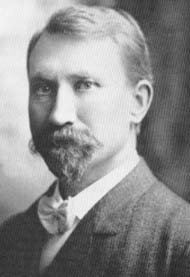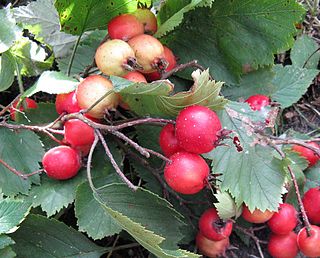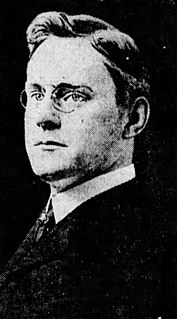Related Research Articles

Crataegus, commonly called hawthorn, quickthorn, thornapple, May-tree, whitethorn, or hawberry, is a genus of several hundred species of shrubs and trees in the family Rosaceae, native to temperate regions of the Northern Hemisphere in Europe, Asia, North Africa, and North America. The name "hawthorn" was originally applied to the species native to northern Europe, especially the common hawthorn C. monogyna, and the unmodified name is often so used in Britain and Ireland. The name is now also applied to the entire genus and to the related Asian genus Rhaphiolepis.

John Torrey was an American botanist, chemist, and physician. Throughout much of his career, he was a teacher of chemistry, often at multiple universities, while he also pursued botanical work, focusing on the flora of North America. His most renowned works include studies of the New York flora, the Mexican Boundary, the Pacific railroad surveys, and the uncompleted Flora of North America.

Crataegus monogyna, known as common hawthorn, one-seed hawthorn, or single-seeded hawthorn, is a species of flowering plant in the rose family Rosaceae. It is native to Europe, northwestern Africa, and West Asia, but has been introduced in many other parts of the world.

Crataegus mollis, known as downy hawthorn or red hawthorn, occurs in eastern North America from southeastern North Dakota east to Nova Scotia and southwest to eastern Texas. The range of this species is from southern Ontario and Michigan to eastern North Dakota and southward to Denison, Texas, and Arizona. This tree inhabits wooded bottomlands, the prairie border, and the midwest savanna understorey.

Torreya is a genus of conifers comprising six or seven species placed in the family Taxaceae, though sometimes formerly placed in Cephalotaxaceae. Four species are native to eastern Asia; the other two are native to North America. They are small to medium-sized evergreen trees reaching 5–20 m, rarely 25 m, tall. Common names include nutmeg yew.

Crataegus laevigata, known as the Midland hawthorn, English hawthorn, woodland hawthorn, or mayflower, is a species of hawthorn native to western and central Europe, from Great Britain and Spain east to the Czech Republic and Hungary. It is also present in North Africa. The species name is sometimes spelt C. levigata, but the original orthography is C. lævigata.

Per Axel Rydberg was a Swedish-born, American botanist who was the first curator of the New York Botanical Garden Herbarium.
Torrey Botanical Society was started in the 1860s by colleagues of John Torrey. It is the oldest botanical society in the Americas. The Society promotes the exploration and study of plant life, with particular focus on the flora of the regions surrounding New York City. Members of the group including Nathaniel Lord Britton and his wife Elizabeth Gertrude Britton founded the New York Botanical Garden.

Crataegus flabellata is a species of hawthorn known by the common name fanleaf hawthorn. It is native to the northeastern United States and adjacent Canada. It is intermediate in appearance between C. macrosperma and C. chrysocarpa. C. macrosperma, which occurs throughout the range of C. flabellata and also in the southeastern U.S., is often misidentified as C. flabellata.

Crataegus marshallii is a species of hawthorn known by the common name parsley hawthorn. It is native to the southeastern United States.

Crataegus submollis, known as the northern downy hawthorn, northern red haw, Quebec hawthorn, or hairy cockspurthorn, is a species of hawthorn that grows to about 7 m in height and typically carries large crops of red fruit.

Eugene Pintard Bicknell was an American botanist and ornithologist.

Willard N. Clute (1869–1950) was an American author, naturalist and botanist. He was born in Steuben County, New York, the son of George N. and Ruth Wright Clute. He married Ida Martin, who illustrated some of his works.

Elizabeth Gertrude Britton was an American botanist, bryologist, and educator. She and her husband, Nathaniel Lord Britton played a significant role in the fundraising and creation of the New York Botanical Garden. She was a co-founder of the predecessor to the American Bryological and Lichenological Society. She was an activist for protection of wildflowers, inspiring local chapter activities and the passage of legislation. Elizabeth Britton made major contributions to the literature of mosses, publishing 170 papers in that field.

Anna Murray Vail was an American botanist and first librarian of the New York Botanical Garden. She was a student of the Columbia University botanist and geologist Nathaniel Lord Britton, with whom she helped to found the New York Botanical Garden.
Edward Lyman Morris (1870–1913) was an American botanist.

Charles Stuart Gager was an American botanist who served as director of the Brooklyn Botanic Garden for over 30 years. He served as president of the Botanical Society of America and the Torrey Botanical Club. Born in Norwich, New York, he graduated from Syracuse University in 1895, and earned a PhD at Cornell in 1902. Between 1895 and 1910 he taught biology and botany at New York State Normal College, Rutgers University, New York University, and the University of Missouri, and was laboratory director at the New York Botanical Garden. He was called to direct the Brooklyn Botanical Garden in 1910, and under his directorship the Garden expanded its role in public education, especially children's education. His works include the textbooks Fundamentals of Botany (1916) and General Botany, with Special Reference to its Economic Aspects (1926). He died in Waterville, Maine.
Inez Maria Haring was an American botanist and plant collector, best known for her work in bryology as the Assistant Honorary Curator of Mosses at the New York Botanical Garden beginning in 1945.
Elizabeth Dorothy Wuist Brown (1880-1972) was an American botanist noted for studying apogamy in plants, as well as flora of New Zealand, French Polynesia, and Hawaii. She was married to botanist Forest Buffen Harkness Brown, with whom she was a coauthor. The standard author abbreviation E.D.Br. is used to indicate this person as the author when citing a botanical name.

John Howard Redfield was an American botanist, conchologist, and businessman. He was a founder of the Botany section of the Academy of Natural Sciences of Philadelphia, and his chief botanical works include "Geographical Distribution of the Ferns of North America" and Flora of Mount Desert Island, Maine.
References
- ↑ Stafleu, F.A.; Cowan, R.S. (1976–1988), "Eggleston, Willard Webster (1863–1935)", Taxonomic literature: A selective guide to botanical publications and collections with dates, commentaries and types. Second Edition, Utrecht: Bohn, Scheltema and Holkema; Available online through Smithsonian Institution Libraries
- ↑ Rickett, H.W. (1936), "Forms of Crataegus pruinosa", Botanical Gazette, 97 (4): 780–793, doi:10.1086/334603, JSTOR 2471527
- ↑ Dickinson, T.A.; Campbell, C.S. (1991), "Population structure and reproductive ecology in the Maloideae (Rosaceae)", Systematic Botany, 16 (2): 350–362, doi:10.2307/2419285
- ↑ Brown, H.B. (1910), "The genus Crataegus, with some theories concerning the origin of its species", Bulletin of the Torrey Botanical Club, 37 (5): 251–260, doi:10.2307/2479407
- ↑ IPNI. Eggl.